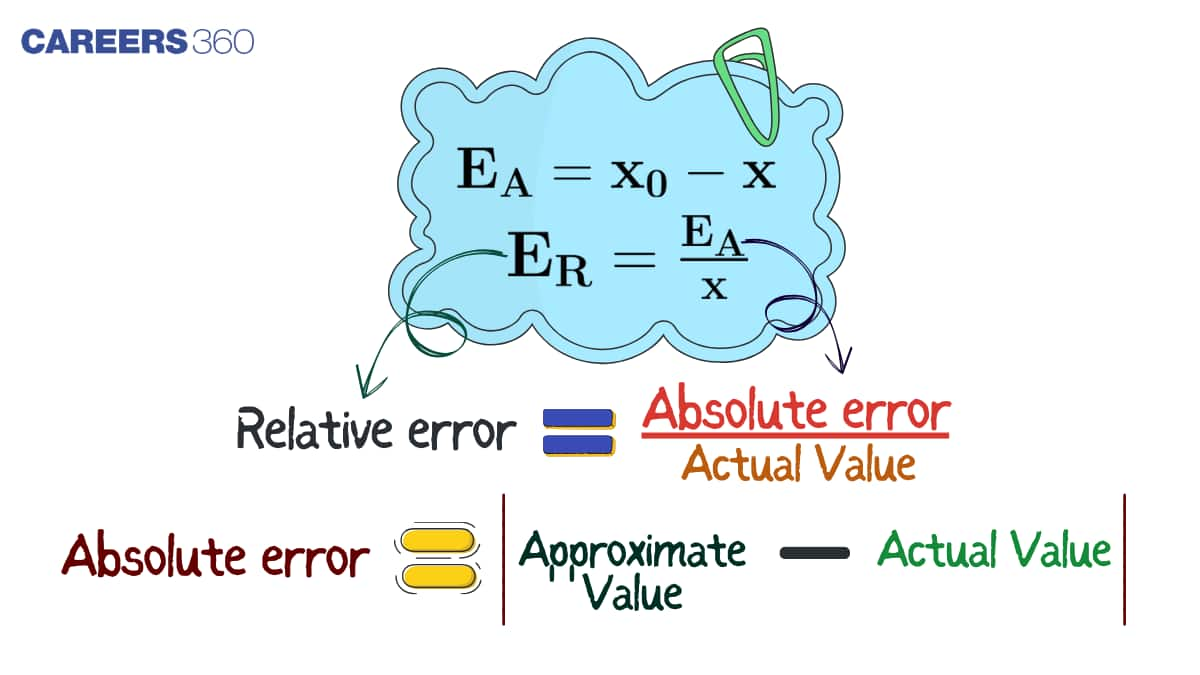Absolute and Relative Error- Definition, Formulas, and Examples
Measurements are one of the most important parts of scientific computing. Absolutely accurate measurement results are very rare. Small errors are common when measuring different parameters. There are various types of errors that lead to measurement errors. Each and every error can be expressed mathematically. If we know the error, we can find a way to calculate it correctly and fix the error. There are two main types of error: absolute error and relative error. This article defines absolute and relative errors. Descriptions, formulas, and examples of absolute and relative errors are given here, along with their definitions. Knowledge of various errors is necessary for the measurement.
This Story also Contains
- Absolute Error
- Formula For Absolute Error
- Example Of Absolute Error
- Relative Error
- Formula For Relative Error
- Example Of Relative Error

Absolute Error
The difference between actual quantity and measured quantity is known as absolute error. Importance of these types of errors totally depends on the types of quantity measured. As we know that street distance is very large so, a very small error if comes in measurement will be ignored. A centimeter error is significant when measuring the length of mechanical parts. In both cases, the error is very small (in centimeters), but the error in the second case is more significant.
Formula For Absolute Error
Absolute error is calculated by taking the absolute difference between the expected value of the quantity and the actual measured value.
Suppose actual measured value is M and expected value is E then absolute error is equal to absolute value of E minus M i.e, |E-M|. We have to note that,
Absolute error is always positive as it is the absolute value of the difference.
Here, the expected value can also be mentioned as theoretically calculated value or value mentioned in books, features, etc.
Example Of Absolute Error
Here we take day-to-day life examples of absolute error. Suppose we have a pencil and its expected or theoretically written length is equal to 16 cm, but the actual measured length of the same pencil is 15.95 cm. Now we know that absolute error is equal to absolute value of actual measured value minus expected value of quantity.
Absolute error is equal to 16 minus 15.95 which is equal to 0.05 cm.
Relative Error
When we divide absolute error by expected value then we get a new value which is known as relative error. In other words, it is a ratio between the absolute error and theoretically expected value. Once we calculate the relative error, we will get an idea about the accuracy of our measurement. You can also calculate absolute error if you know about the relative error. It does not have any dimension or unit. When we express relative error in percentage, it is known as percentage error.
Formula For Relative Error
It is the ratio between the absolute error and theoretically expected value.
Let absolute error equal to x and expected value equal to y and relative error is RE, then relative error RE is given by,
$RE = \frac{x}{y}$
Example Of Relative Error
Here we take day-to-day life examples of absolute error. Suppose we have a pencil and its theoretically mentioned length is equal to 16 cm, but the actual measured length of the same pencil is 15.5 cm. Now we know that when we divide absolute error by expected value then we get a new value which is known as relative error.
First, calculate the absolute error. Absolute error is equal to 16 minus 15.5 which is equal to 0.5 cm.
Now the relative error will be equal to ![]()
$RE = \frac{{0.5}}{{16}} = 0.03125$
Frequently Asked Questions (FAQs)
The difference between expected quantity and actually measured quantity is known as absolute error.
When we divide absolute error by theoretically expected value then we get a new value which is known as relative error. In other words, it is the ratio between the absolute error and theoretically expected value.
Suppose we have a gear and its theoretically expected diameter length equal to 2 cm, but on measurement, we find the diameter length to be 1.96cm. Now we know that absolute error is equal to absolute value of theoretically expected value minus measured value of quantity.
Absolute error is equal to 2 minus 1.96 which is equal to 0.04 cm.
Suppose we have a gear and we are calculating its diameter. On theoretical calculations, the length measurement is expected to be 2 cm, but the measured length comes out to be 1.96 cm. Now we know that when we divide absolute error by actual value then we get a new value which is known as relative error.
First, calculate the absolute error. Absolute error is equal to 2 minus 1.96 which is equal to 0.04 cm.
Now the relative error will be given by,
![]()
\[RE = \frac{{0.04}}{{2}} = 0.02\]
The amount by which actual quantity is differing from its expected or theoretical value is known as error.